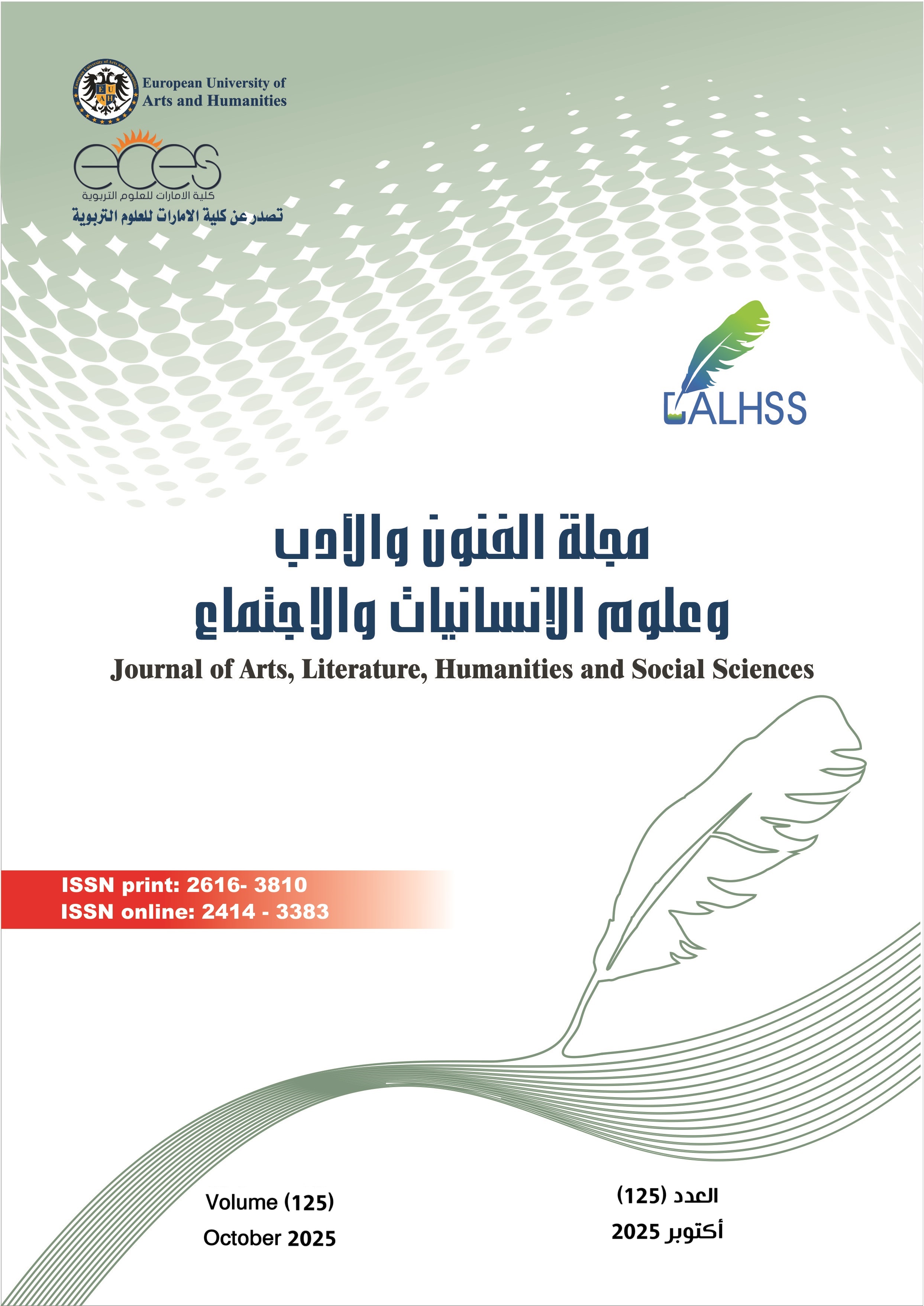A Contemporary Vision of Rawashin in 3D-Printed Textile Design
Abstract
The world is evolving rapidly, and this period may be the fastest in history in terms of inventions, scientific discoveries, and progress across all fields. Undoubtedly, our current era is characterized as the era of rapid and advanced modern technology, due to the widespread penetration of technology and its diverse and multifaceted applications in all areas of life. Day after day, we are shocked by the creativity and inventions produced by these modern technologies, which astound us with their ingenuity. This has led them to enter the world of women's fashion with force, dominating the most beautiful looks for women. A major turning point in the relationship between fashion and digital technology occurred in 2015. The world is witnessing significant development with the increasing use of 3D printing technology. It is believed that the use of such technologies plays a fundamental role in transforming imaginative and innovative forms into real-life works and products with extreme precision and within record timescales. This helps innovative designers unlock the potential of ideas that were previously limited by traditional implementation methods, particularly in the field of fashion design, where the use of 3D printing technology is in its infancy. The global and Arab library still lacks relevant research on 3D printing.
It is one of the most significant technologies developed in recent years, and its applications have expanded significantly, serving a diverse range of fields. Technology is the primary factor in development and change. With the emergence of computer-aided design (CAD) programs, they have not replaced talent but have helped in fashion innovation and increased productivity. The fast-paced lifestyle demands more clothing, leading fashion to meet these needs.
References
2. بغدادي، أحمد خليل. (2007). ابتكار نظام تجريبي لتصميم المنسوجات بمساعدة الحاسب الآلي وتنفيذها بأكثر من أسلوب تنفيذي (رسالة دكتوراة، كلية الفنون التطبيقية، المحرر).
3. التحول الوطني يستعرض أبرز منجزاته لدعم أهداف الأمم المتحدة للتنمية المستدامة. (2020، 26 نوفمبر). الرياض، المملكة العربية السعودية. https://www.aleqt.com/2020/11/26/article_1979036.html
4. تويج، علي حمود. (2020). أثر استخدام طابعة ثلاثية الأبعاد في تنفيذ تصاميم النحت الفخاري. مجلة لارك للفلسفة واللسانيات والعلوم الاجتماعية, 1(36), 56–68. https://doi.org/10.31185/lark.Vol1.Iss36.1264
5. الجمل، جيهان. (2016). أقمشة ملابس السيدات المطبوعة ثلاثية الأبعاد. مجلة التصميم الدولية, 11(1), 25–35. https://doi.org/10.12816/0036509
6. حجازي، حنان. (2011). إعادة توظيف العناصر المعمارية التقليدية في المسكن الحجازي المعاصر. مجلة بحوث التربية النوعية, 6(1) , 78–92.
7. حريري، مجدي محمد. (1991). صحة الدار والتطلع إلى السماء. دار المجتمع.
8. حسن، شيرين. (2017). وضع منظومة لتصميم الأزياء بالاعتماد على البرامج الرقمية. الجمعية العلمية للمصممين, 335–344.
9. حمودة، بسمة. (2017). وضع منظومة لتصميم الأزياء بالاعتماد على برامج تصميم الأزياء الرقمي: التكنولوجيا الحديثة ودورها في إثراء المصنوعات الجلدية. مجلة التصميم الدولية, 10(3) , 110–122.
10. الخرباوي، راندا. (2019). التنمية المستدامة للزخارف الإسلامية باستخدام الطباعة ثلاثية الأبعاد وتوظيفها في تزيين عباءة المرأة. في المؤتمر السنوي الرابع عشر: التعليم النوعي وتطوير القدرة التنافسية والمعلوماتية للبحث العلمي في مصر والوطن العربي, 101–115. المنصورة: دار منظومة.
11. خضير، فريال مصطفى. (1983). البيت العربي في العراق في العصر الإسلامي. المؤسسة العامة للآثار والتراث.
12. زكريا، فؤاد. (1981). النقد الفني دراسة جمالية وفلسفية (كتاب مترجم للمؤلف جيروم ستوليز).
13. السكاكر، صالح. (2018). واقع التنمية الاجتماعية المستدامة في ضوء رؤية المملكة 2030. الرياض: جامعة نايف العربية للعلوم الأمنية. https://repository.nauss.edu.sa/handle/123456789/65904
14. صالح، محمود حامد محمد. (1988). مداخل تجريبية لإثراء مجال الأشغال الفنية في ضوء الاتجاهات الفنية الحديثة (رسالة دكتوراة).
15. عبد الباسط، نيرمين. (2019). استحداث تصميمات مستوحاة من جماليات فن الأبرو باستخدام برامج الحاسب. مجلة العمارة والفنون, 6(1) , 42–55.
16. عبد الجواد، توفيق أحمد. (1985). معجم المصطلحات الفنية في العمارة وإنشاء المباني.
17. عطية، رانيا. (2016). تقنيات ثلاثية الأبعاد في تصميم وإنتاج الملابس. الجمعية العلمية للمصممين, 5(2), 50–62.
18. علام، ليلى، & المنتصر، إيمان. (2009). الروشان في بيوت مكة القديمة وانعكاسها على تحقيق مشغولة يدوية مبتكرة. مجلة علوم وفنون, 4(2), 77–88.
19. المرحم، فريدة محسن. (1995). الروشان والشباك وأثرهما على التصميم الداخلي في بيوت مكة التقليدية في أوائل القرن الرابع عشر الهجري (رسالة ماجستير).
20. مرزوق، محمد عبد العزيز. (1987). الفنون الإسلامية في العصر العثماني.
21. المرصفي، عواطف فتح الله. (1972). توليف بعض خامات النخيل لتحقيق الابتكار في مجال التربية الفنية (رسالة ماجستير).
22. مزروع، السيد محمد. (2009). الاستفادة من رسوم الحاسب ثلاثية الأبعاد في البناء الشكلي للمشغولات المعدنية. المؤتمر العلمي السنوي, 3(1) , 12–25.
23. المنتصر، إيمان. (2013). جماليات الرواشين في مشغولات فنية برسوم الحاسب ثلاثية الأبعاد. مجلة البحوث النوعية, 8(2) , 45–58.
24. مهران، شحاتة. (2019، مايو). تطبيقات الطباعة ثلاثية الأبعاد في مجال التصميم الداخلي والأثاث. دار منظومة, 327–348.
25. نظيف، عبد السلام أحمد. (1989). دراسات في العمارة الإسلامية.
26. Jewon, L. (2017). Understanding millennial consumers’ adoption of 3D printed fashion products by exploring personal values and innovativeness. Kent State University.
27. Lushan, S., & Li, Z. (2017). Envisioning the era of 3D printing: A conceptual model for the fashion industry. Fashion and Textiles, 4, Article 25. https://doi.org/10.1186/s40691-017-0112-2
28. Jaehoon, C. (2019). A study of the development and improvement of fashion products using a FDM type 3D printer. https://fashionandtextiles.springeropen.com/articles/10.1186/s40691-018-0162-0
29. Sameath, T. (2020). 3D printing technology of polymer fiber composites in the textile and fashion industry: A potential roadmap for a consumer concept. Carlina University.
30. Greder, K. C. (2020). Design in 3D: A computational fashion design protocol. International Journal of Clothing Science and Technology, 32(4), 537–549. https://doi-org.sdl.idm.oclc.org/10.1108/IJCST-07-2019-0110
31. Perry, A. (2018). 3D-printed apparel and 3D-printer: Exploring advantages, concerns, and purchases. International Journal of Fashion Design, Technology and Education, 11(1), 95–103. https://doi.org/10.1080/17543266.2017.1306118
Copyright (c) 2025 شهد محمد سعد القحطاني

This work is licensed under a Creative Commons Attribution-ShareAlike 4.0 International License.



